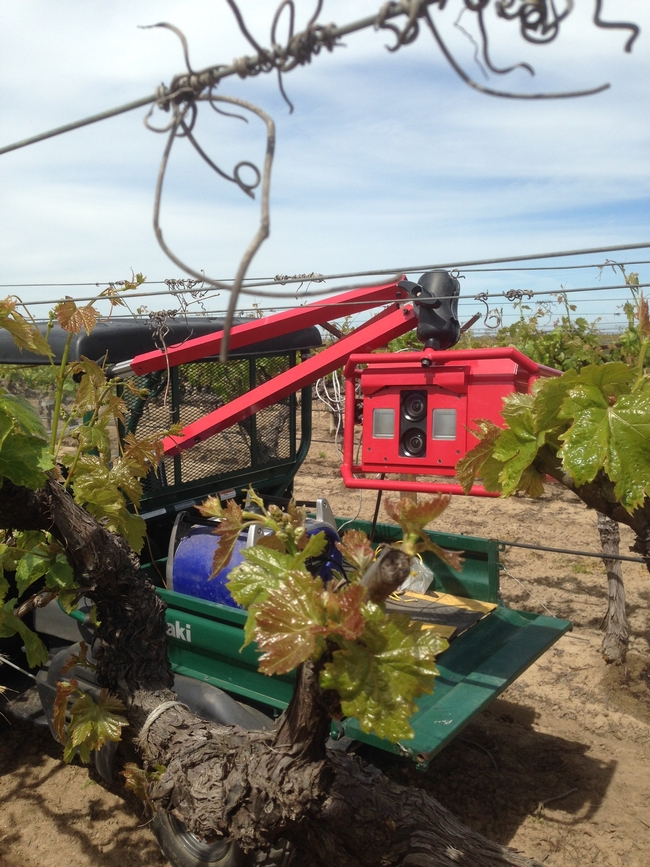Sustainable grape production and precision viticulture
Grape acreage being removed from production and the strong demand for nut tree crops have grape growers concerned about the economic sustainability of grape production in the San Joaquin Valley. The gross income of grapes per acre depends on two elements: price per ton and tons per acre. Price per ton is determined by a lot of factors, e.g. quality, region, demand, and inventory, and it is really difficult to predict the price per ton for a certain vintage. So the major target for growers is to achieve the optimum tons per acre from their vineyards.
Recently, it seems we have reached a plateau of production with current planting materials and management methods in the San Joaquin Valley vineyards. Making a vineyard less variable with more uniformly productive grapevines regardless of their location within a given vineyard is the most important question to the viticulturists.
Vineyard variability was first studied in Australia, and the yield variation within-vineyard is typically of the order of 8 to 10 fold . The fruit quality variation might follow the similar pattern as yield variation under or over a certain crop load window. Differential harvest was first applied in Australia with yield monitor installed on the mechanical harvesters to separate the low yield zone and high yield zone for high quality and low quality fruit for different wine programs. It was an improvement from the winemaking point of view. However, differential harvest still didn't solve the problem of vineyard variability for both yield and quality. Then viticulturists started to think of differential management or even differential planting may provide a solution to variation in vineyards.
Then the question becomes: is the variation pattern always consistent? Unlike annual broadacre crops, e.g. corn or soybeans, grapevines are a perennial crop and the yield variation carry-over effect is always something important for viticulturists to keep in mind. Initial research results suggested the variation pattern can be consistent in 2 years' period. However, different site location may contribute to vineyard variation as well. Soil texture, water holding capacity, and soil mineral nutrient content were believed to be the main cause of the variability. Further investigation is needed to confirm that the variation pattern is somehow consistent and manageable to make the vineyards produce uniformly.
Once it is assessed vineyard variability can be managed. Defining vineyard variability becomes the next question. Assessing vineyard variability visually may not be possible for large vineyards. Yield monitoring, on the other hand, is only suitable to define the variability at harvest and might be also financially difficult for small growers. Early detection of the vineyard variability in order to manage the vineyard differentially is an active area of research. Currently, different sensors have become available for vineyard managers to tell how much variability is in the vineyard through measurement of canopy reflectance through use of NDVI, thermal images, irrigation scheduling using sap flow sensors and availability of soil moisture through measurement of soil matric potential. UAVs and satellite imagery are also available to assess vineyard variability at an economical cost, as they may provide larger data sets with relative cheap cost. However, ground-truthing is needed to make sure how accurately these data from different sensors define the variability in the vineyard.
Recently, Cornel University, Carnegie Mellon, and UC Davis were awarded a $6 million grant from the USDA's Specialty Crop Research Initiative (SCRI) to further study the proximal sensing, crop estimation, and soil mapping to develop tools for variable rate management in table and wine grape vineyards. The goal of the project is to increase/optimize yield and quality within a vineyard by spatially tuning (a) vine balance and (b) canopy light microclimate.
The challenge for San Joaquin Valley grape growers is to make grape growing more economically sustainable for future generations. Optimizing yield per acre with less labor and energy inputs should be the goal of growers. Reducing the vineyard variability to have more uniform production might give growers more profit per acre by increasing the yield per acre without adversely affecting fruit quality. Ultimately, new breeding materials will be the long term goal to increase the yield potential and profitability for vineyards.


